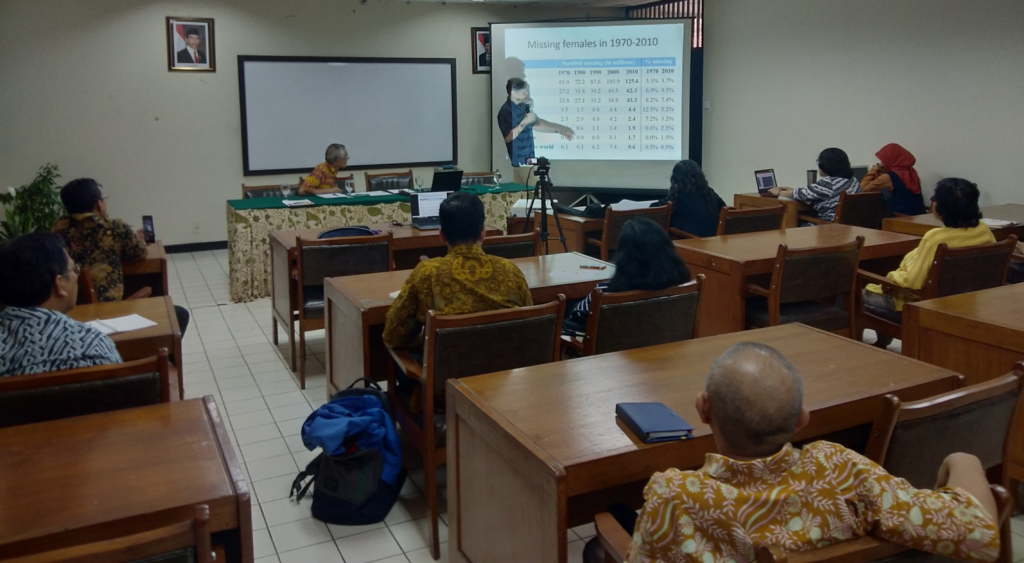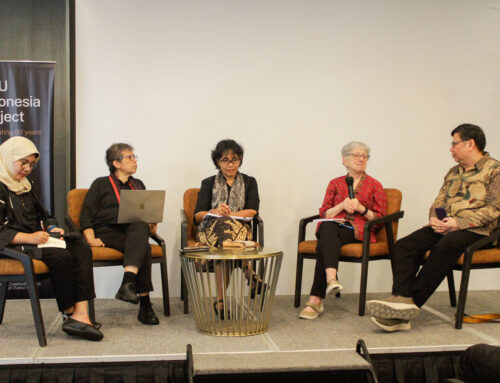On 22 May 2018, Lembaga Demografi, Faculty of Economics and Business Universitas Indonesia (LD FEB UI) hosted the FKP seminar in Jakarta by Cristophe Guilmoto of Centre Population et Développement, Université Paris Descartes (CEPED/IRD Paris) presented his study on demographic masculinization and son preference phenomenon in Southeast Asia, by taking Viet Nam and Indonesia as case studies. Demographic masculinization is a term used to indicate the preference for male descendants. He selected the two regions with a different child preference cultures to find out whether Southeast Asia is affected by demographic masculinization and the cause and challenges arising from the phenomena.
Demographic masculinization is a 5-25% excess male births showed by increasing sex ratios at birth (105 to 110-130 male births per 100 female births). The likely caused is thought to be mostly sex-selective abortions, where parents diagnosed having future daughters are likely to undergo abortion. The result is a rise of sex imbalance issues and loss of female population as many as 125.6 million by 2010. Some consequences of the imbalance includes the family planning campaign (China), inflation of the dowry paid by the bride’s parents (India), economic crisis and civil wars (Eastern Europe), genetic differences (everywhere), an others. There are three preconditions of modern sex selection to support earlier theorie, i.e. 1) increasing sex selection technology (in forms of ultrasound, abortion techniques, fetal blood tests); 2) declining fertility rate (which occurred in Asia and Eastern Europe, reducing the chance of male offspring); and 3) high preference for sons (due to a boy’s social and cultural role in patrilineal societies).
Cristophe Z. Guilmoto (CEPED/IRD Paris) shared his study on demographic masculinization at LD FEB UI, 22 May 2018
Christophe shared findings from Vietnam where the country’s latest Sex Ratio at Birth (SRB) showed a gradual increase for the last 14 years. This is followed by low fertility in Vietnam, especially in cities and coastal areas. Sex selection technologies have also affected supply side of populations in Vietnam. These technologies were firstly found in urban areas, although no difference of SRB found in urban and rural areas. Another factor that affected SRB trend was the cultural tradition of having boys over girls such as old age support and family labor, which is common in patrilineal societies such as Vietnam.
Christophe did not find a significant preference or sex selection phenomenon in Indonesia. This was due to some factors such as moderate fertility; lack of abortion facility for women; no son preference given societies mostly attached to kinship, and normal SRB trend. From the latest census, it was found that there was an almost equal number of daughter-in-law and son-in-law in Indonesian households, which indicated a neutral sex preference. However, there were also significant differences of SRB across regions or ethnicities in Indonesia. The study distinguished patrilocal groups to deepen the analysis on the regional difference on SRB, where west Indonesia patrilocal groups include Balinese, Chinese, Lampung, and Bataknese and east Indonesia groups. East Indonesia patrilocal groups include Lombok, Mollucans, Papuans, etc. It was found that both groups have high SRB, indication for preference of sons, with east Indonesia having higher SRB, followed by SRB of patrilocal groups, west Indonesia, and Indonesia on average.
The study also included kinship system in Vietnam and Indonesia as one factor that determined gender arrangements. The kinship system noted some behavioral decision made by households, such as married children’s decision to reside with which parents, wherein the case of Vietnam, it is considered as a shame for parents to have support from married daughters. However, in both countries, it was concluded that the decision was taken under pressure of kinship norms, but irrespective of other cultural and economic considerations. Along with that conclusion, the study also concluded that there was traces of sex imbalances in Southeast Asia (in this case, Indonesia and Vietnam), where the phenomena only affect several areas in Vietnam and several patrilocal groups in Indonesia.
For the complete presentation and Q&A session, please refer to the videos and materials provided.





